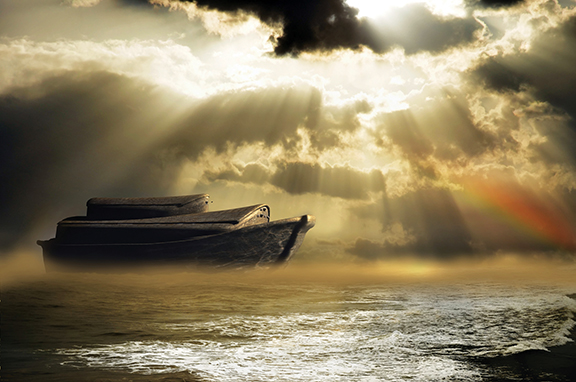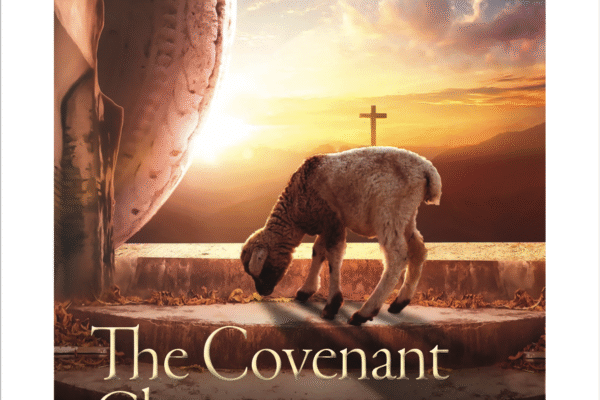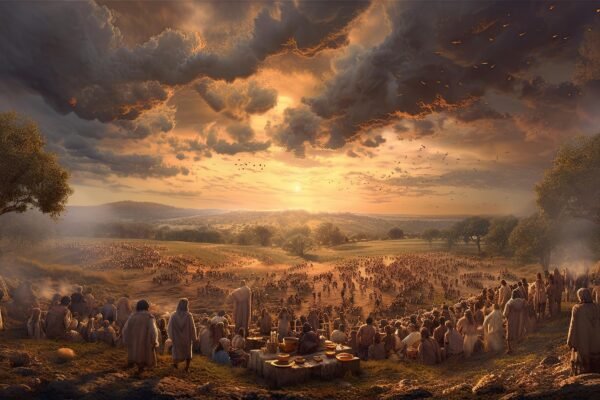The word baptism and its variants appear almost one hundred times in the New Testament, but never in the Old Testament. Something exceptional was happening on the sandy banks of the Jordan River in anticipation of the Messiah and His kingdom, something unique to the redemptive event of Jesus Christ, something that would remain a basic distinguishing mark of faith for millennia of disciples born from its living waters.
But as we meander through the New Testament writing about baptism, we notice an unexpected feature. Although baptism is not mentioned in the Old Testament, when the New Testament speaks of baptism, it often finds it attendant with and prefigured in some of the Old Testament’s most familiar stories. This pattern of use both recalls the long flow of salvation history and enriches our understanding of baptism itself.
Let’s take a look.
John meets Isaiah
When John the Baptist bursts onto the opening pages of all four Gospels, his ministry is said to be preparatory. “Repent, God’s kingdom is almost here!” he cries. And so it begins. Multitudes hear and confess and are plunged beneath the waters of the Jordan.
John is not a surprise for Israel, at least not for those familiar with Scripture. He was expected. Matthew, Mark, Luke, and John all tie the wilderness Baptist to a prophecy of Isaiah. The Gospel of Luke quotes the largest portion of it in reference to John:
The voice of one crying in the wilderness:
“Prepare the way of the Lord;
Make His paths straight.
Every valley shall be filled
And every mountain and hill brought low;
The crooked places shall be made straight
And the rough ways smooth;
And all flesh shall see the salvation of God (Luke 3:4-6; Isaiah 40:3-5).
Get ready! The Lord God is coming to reign. That’s the good news Isaiah proclaims (40:9, 10). John fulfills that cry. There is water and Spirit aplenty in this “wilderness” to baptize the repentant in expectation of YHWH and His kingdom. Intriguingly, Isaiah specifically mentions these baptismal ingredients just a few sentences later. Looking both forward and back, he sees the “waters” and “Spirit” of Creation — old and new:
Who has measured the waters in the hollow of His hand . . .
Who has directed the Spirit of the Lord . . . ? (40:12, 13).
The Bible begins with the Spirit hovering like a bird over the waters (Genesis 1:2) — Creation! This image is repeated at the beginning of the New Testament when the Spirit descends dove-like after Jesus’ water baptism (Matthew 3:16) — new Creation!
Old mingles in New. John the Baptist and Isaiah the prophet are joined as ministers of salvation in God’s creative works, and in baptism we are united with them in that ongoing story of water and Spirit, the lived story of our Creator.
Peter and the Flood
When the apostle Peter discusses baptism, the analogous story of Noah and his ark springs to his mind. Peter’s retrospective figuration of Flood with baptism is potent:
They formerly did not obey, when God’s patience waited in the days of Noah, while the ark was being prepared, in which a few, that is, eight persons, were brought safely through water. Baptism, which corresponds to this, now saves you, not as a removal of dirt from the body but as an appeal to God for a good conscience, through the resurrection of Jesus Christ . . . (1 Peter 3:20, 21, ESV).
Peter is telling two stories — the days of Noah and Jesus Christ — and baptism narrates both. The Flood is God’s judgment on the world, the drowning of wickedness, and the restoring of creation. For the few of faith, the ark lifts up and “through water” brings salvation (Genesis 6-8). In the wider context, Peter conflates both Flood and baptism with the story that defines both: Jesus crucified and resurrected for our atonement.
The Passion is universal Flood in a man: the death-to-life story of Jesus. Peter writes, “Christ also suffered once for sins, the just for the unjust, that He might bring us to God, being put to death in the flesh but made alive by the Spirit” (1 Peter 3:18). Jesus condemns sin in His death and defeats death in His resurrection, bringing salvation to all.
New mingles with Old. Peter and Noah become companions in this message of God’s judgment and restoration as Flood and Cross converge in our baptism, and the truth of both is reenacted and embraced in water and in faith toward our Savior.
Paul and the Red Sea
When the apostle Paul speaks of baptism in 1 Corinthians 10, he invites us to adopt the Exodus generation as “our fathers” and to reread their one-time crossing of the Red Sea and ongoing wilderness journey “under the cloud” as symbolic illustration of the water/Spirit baptism we have experienced:
Moreover, brethren, I do not want you to be unaware that all our fathers were under the cloud, all passed through the sea, all were baptized into Moses in the cloud and in the sea. . . . But with most of them God was not well pleased, for their bodies were scattered in the wilderness (vv. 1, 2, 5).
Paul tells a cautionary story: “Now these things became our examples . . . and they were written for our admonition . . .” (vv. 6, 11). The Corinthian church is carnal, just as Israel was (3:1-4). The Israelites began their journey of discipleship with a “baptism” after God’s saving act but later fell in the wilderness. The Corinthians are also baptized disciples but risk falling away into lust and idolatry, so they must be rebuked (10:6-14).
Israel prefigures the church. Israel followed Moses through the sea, but only after they encountered God’s redemption in a sacrificed lamb (Exodus 12, 14). Their “baptism” signified a trusting obedience to follow God in all things, even through the deep. But Israel’s life beyond the sea did not live up to that sign, just as we, and the Corinthians — though baptized and following Jesus — can fall short of it and so too must be warned.
Old mingles with New. Paul and Moses join forces to alert the people of God of what befalls those who stray from the testimony of baptism — a beginning, not end, which informs the whole stream of our discipleship in service to our Lord and God.
Jesus to Abraham
Baptism is a drama typologically tied to key stories of Scripture. Each baptism is a small but special reenactment of the Bible’s central story: Jesus died and raised. And each earlier story symbolically points toward, and mingles with, Him: Creation, Flood, and Exodus, with all the power, promise, and warning that attend them.
Baptism is a leap of faith that publicly signifies our commitment to be immersed in God’s story of salvation and walk of faith. Baptism tells this story and is our promise to live this story and make it our own as disciples (Matthew 28:19). The story is old and new, as wide as Genesis is from Revelation. We have heard it in John and Isaiah, in Peter and Noah, in Paul and Moses.
But we hear it chiefly, and most clearly, in our Lord Jesus Christ, in whom we die and are raised again — by baptism (Romans 6:1-4; Colossians 2:12).
In the water and Spirit of baptism, in Jesus, we span all these stories and more. As Paul writes, in baptism we are united with Christ and so reach, in faith, all the way back to the father of faith, Abraham himself: “For as many of you as were baptized into Christ have put on Christ. . . . And if you are Christ’s, then you are Abraham’s seed, and heirs according to the promise” (Galatians 3:27, 29).
New mingles with Old again.
Crossing the River
Of father Abraham, God says, “I took your father Abraham from the other side of the River, led him throughout all the land of Canaan, and multiplied his descendants and gave him Isaac” (Joshua 24:3).
Like Abraham, disciples of Jesus Christ once lived on the other side of the “river” — our former lives in sin and without God. But now passing through the water, we, like Abraham, are “led” of God in Christ as children of promise following on in faith.
As we recall our own baptisms and call others to the waters, let’s mingle the Old with the New, and demonstrate how our individual histories have become a part of the whole history of Creation and Salvation. One Word. One Baptism!







